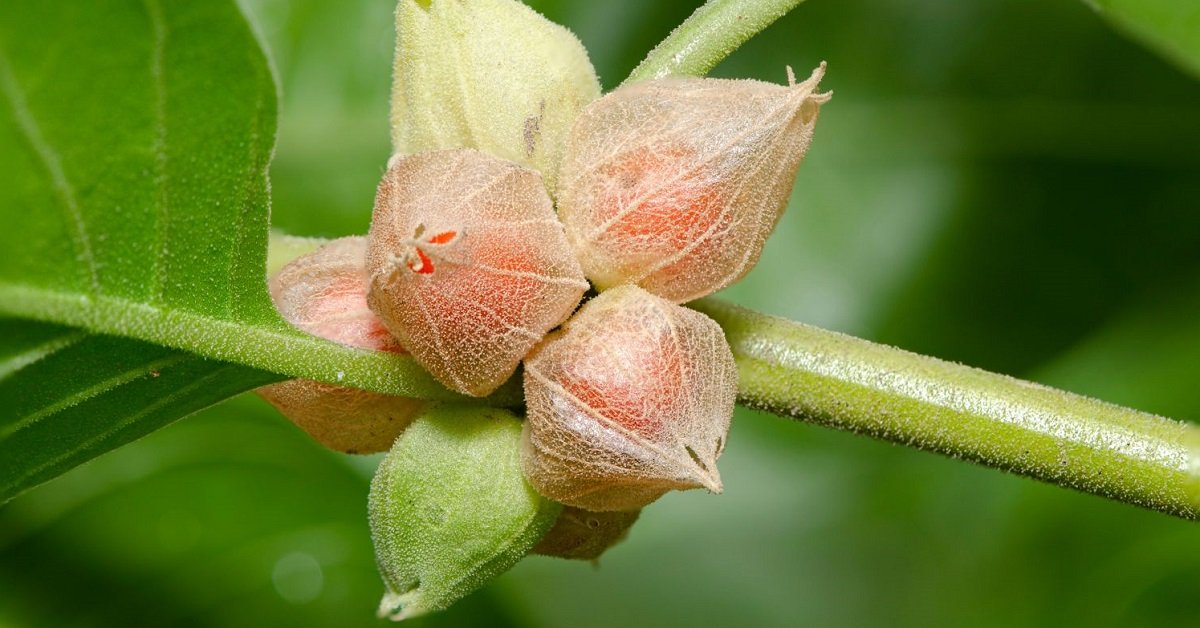Introduction
Ashwagandha (Withania somnifera, fam. Solanaceae) is commonly known as “Indian Winter cherry” or “Indian Ginseng”. It is one of the most important herb of Ayurveda (the traditional system of medicine in India) used for millennia as a Rasayana for its wide range of health beefits.
Ayurveda, the traditional system of medicine practiced in India can be traced back to 6000 BC. For most of these 6000 years Ashwagandha has been used as a Rasayana. The root of Ashwagandha is regarded as tonic, aphrodisiac, narcotic, diuretic, anthelmintic, astringent, thermogenic and stimulant. The root smells like horse (“ashwa”), that is why it is called Ashwagandha (on consuming it gives the power of a horse). It is commonly used in emaciation (when given with milk, it is the best tonic for Weakness), debility from old age, rheumatism, vitiated conditions of vata, constipation, insomnia, nervous breakdown. The paste formed when roots are crushed with water is applied to reduce the inflammation at the joints. It is also locally applied in carbuncles, ulcers and painful swellings
Anti-inflammatory effect due to Withaferin
Withaferin A and 3-b-hydroxy-2,3-dihydrowithanolide F isolated from Withania somnifera show promising antibacterial, antitumoral, immunomodulating and anti-inflammatory properties
Scientific Studies on Ashwagandha Adaptogenic / Anti-stress effect
Aswagandha is compared well with Eleutherococcus senticosus (Siberian Ginseng) and Panax Ginseng(Chinese / Korean Ginseng) in its adaptogenic properties, and hence it is popularly known as Indian Ginseng. The extensive studies on the biological model of animals for the adaptogenic / anti-stress properties of Ashwagandha have shown it to be effective in increasing the stamina (physical endurance) and preventing stress induced gastric ulcer, carbon tetrachloride (CCl4) induced hepatotoxicity and mortality. Ashawagandha have similar anti-stress activity.
Effect on swimming performance
Ashwagandha was shown to increase swimming performance in animals as judged by increase in swimming time during physical endurance test. Ashwagandha’s antistress properties have been investigated in all these studies using different animals were carried out by swimming endurance stress test. Ashwagandha treated animals showed a significant increase in the duration of swimming time as compared to control. The control group of animals swam for a mean time of 385 minutes, whereas the drug-treated animals continued to swim for a mean duration of 740 minutes. Thus, the swimming time was approximately doubled after Withania somnifera (WS) treatment.
Effect on leucocytosis
Ashwagandha given to a group of animals with milk injection produced reduction in leucocytosis.
Anabolic effects
There was a significant increase in the body weights of the Ashwagandha treated group of animalsas compared to control for a period of 3 months.
Effect on cortisol and ascorbic acid contents of adrenals
The cortisol content of adrenals was reduced significantly in animals subjected to 5 h constant swimming as compared to non-swimmer group. Pretreatment with WS prevented reduction of the cortisol content of adrenals. The ascorbic acid content was also reduced significantly after 5 h of swimming as compared to the animal of non-swimmer group. Pretreatment with WS prevent reduction in ascorbic acid content which occurs after swimming stress. Thus, Withania somnifera treatment prevents, decrease of adrenal cortisol and ascorbic acid which occurs due to swimming stress.

